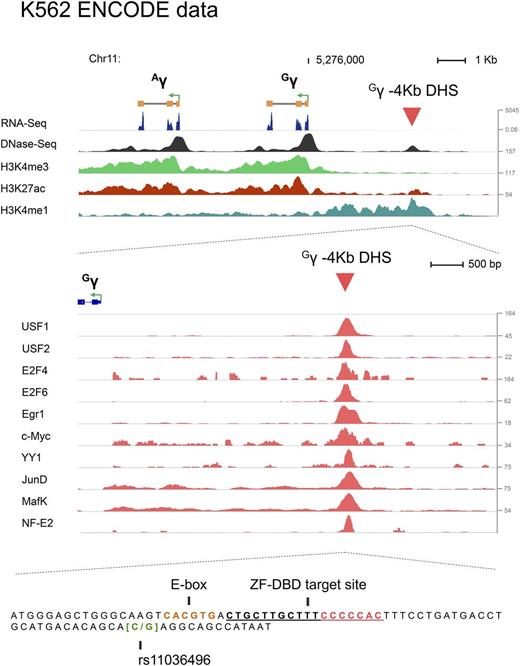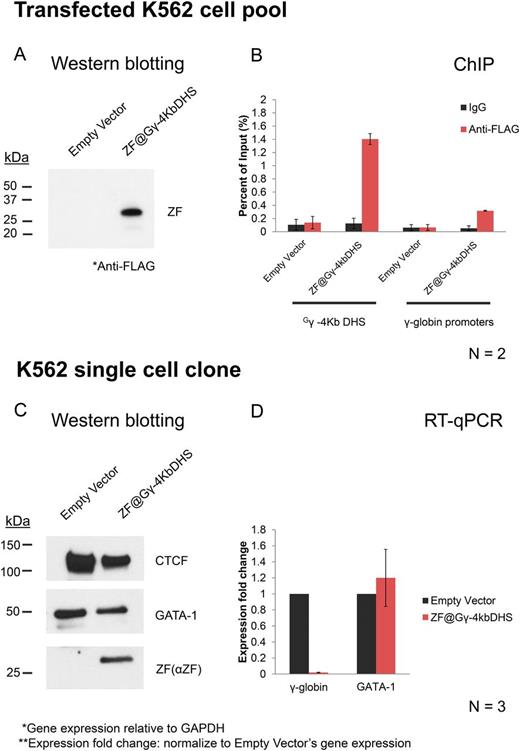Abstract
The human β-globin genes are expressed in a developmental stage-specific manner and regulated by many cis- and trans-regulatory components including a locus control region (LCR) and proximal promoter and enhancer elements. The two γ-globin genes, Gγ and Aγ, are expressed in the fetal period. Persistent expression of γ-globin in the adult ameliorates the symptoms associated with mutations of the adult β-globin gene, such as sickle cell disease or β-thalassemia. Thus, understanding the mechanisms by which the fetal globin genes are activated and silenced during development may lead to new avenues for the treatment of hemoglobinopathies. Using data from the human ENCODE project we identified a DNase I hypersensitive site located 4 Kbp upstream of the Gγ-globin gene (Gγ -4Kb DHS) in K562 cell line. Gγ -4Kb DHS is characterized by the presence of histone modifications typical for enhancer elements (H3K4 monomethylation and H3K27 acetylation) and binding of ubiquitous (USF, E2F, YY1, c-Myc, Egr1, and MafK) or tissue-restricted (NF-E2) transcription factors in K562 cells which express high levels of the γ-globin genes (Figure 1). The presence of USF and NF-E2 is interesting as both proteins have been implicated in the recruitment of transcription complexes to the β-globin gene locus (Crusselle-Davis et al., 2006, Mol. Cell. Biol.; Liang et al., 2009 Mol. Cell. Biol.; Zhou et al., 2010, J. Biol. Chem.; Stee & Hossain et al., 2015, Mol. Cell. Biol.).
We generated and expressed in K562 cells a synthetic Zinc Finger DNA-Binding Domain (ZF-DBD) designed to specifically target the Gγ -4Kb DHS and interfere its activities (ZF@Gγ-4KbDHS). The target site for the ZF-DBD overlaps with a CCCAC Egr1 motif and is close to an E-box sequence, which is predicted to bind USF and c-Myc (Figure 1). Figure 2A and C shows the Western blot results for cells transfected with empty vector or cells expressing the ZF@Gγ-4KbDHS in cell pools or a single cell clone selected from the pool of transfected cells (Figure 2A and C, respectively). We analyzed the binding of ZF@Gγ-4KbDHS at the globin locus in K562 cells using Chromatin Immunoprecipitation (ChIP). The data demonstrate that the ZF@Gγ-4KbDHS efficiently interacted with the Gγ -4Kb DHS and less efficiently with the γ-globin promoters (Figure 2B). Expression of the ZF@Gγ-4KbDHS led to a significant reduction in expression of the γ-globin genes but had no effect on expression of the GATA-1 gene (Figure 2D).
The data suggest that the Gγ -4Kb DHS contributes to high-level γ-globin gene expression in K562 cells. Additionally, a SNP (rs11036496, Figure 1) within the Gγ -4Kb DHS has been reported to be associated with a disorder of γ-globin gene expression in African Americans and Chromatin Conformation Capture (3C) experiments showed that the Gγ-globin upstream region participates in interactions with the LCR and γ-globin genes (Shriner et al., 2015, BMC Medical Genetics; Kiefer et al., 2011, Blood). Therefore, further characterization of the Gγ -4Kb DHS will enhance understanding molecular mechanism(s) regulating hemoglobin switching.
Epigenetic signatures and transcription factor binding at the Gγ -4Kb DHS. Shown on top are the two γ-globin genes and the relative position of the Gγ -4Kb DHS. Shown on the bottom is an enlarged view of the Gγ -4Kb DHS and binding peaks for several transcription factors as indicated.
Epigenetic signatures and transcription factor binding at the Gγ -4Kb DHS. Shown on top are the two γ-globin genes and the relative position of the Gγ -4Kb DHS. Shown on the bottom is an enlarged view of the Gγ -4Kb DHS and binding peaks for several transcription factors as indicated.
Reduced expression of γ-globin in K562 cells expressing the ZF@Gγ-4KbDHS. K562 cells were transfected with a plasmid expressing the ZF@Gγ-4KbDHS or with an empty vector. The K562 cells (pool) were subjected to Western blotting (A) and to Chromatin Immunoprecipitation (ChIP) using antibodies specific for the FLAG-tag, which is linked to the ZF@Gγ-4KbDHS, or negative control antibodies IgG (B). Single clonal K562 cells were subjected to Western blotting using antibodies specific for the ZF-DBD backbone (αZF) or for CTCF or GATA-1 as indicated (C). The single cell clone expressing the ZF@Gγ-4KbDHS was subjected to expression analysis by RT-qPCR using primers specific for γ-globin or GATA-1 as indicated (D).
Reduced expression of γ-globin in K562 cells expressing the ZF@Gγ-4KbDHS. K562 cells were transfected with a plasmid expressing the ZF@Gγ-4KbDHS or with an empty vector. The K562 cells (pool) were subjected to Western blotting (A) and to Chromatin Immunoprecipitation (ChIP) using antibodies specific for the FLAG-tag, which is linked to the ZF@Gγ-4KbDHS, or negative control antibodies IgG (B). Single clonal K562 cells were subjected to Western blotting using antibodies specific for the ZF-DBD backbone (αZF) or for CTCF or GATA-1 as indicated (C). The single cell clone expressing the ZF@Gγ-4KbDHS was subjected to expression analysis by RT-qPCR using primers specific for γ-globin or GATA-1 as indicated (D).
No relevant conflicts of interest to declare.
Author notes
Asterisk with author names denotes non-ASH members.



This feature is available to Subscribers Only
Sign In or Create an Account Close Modal